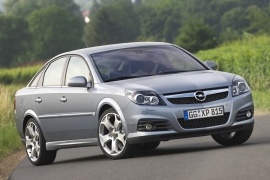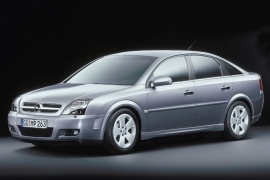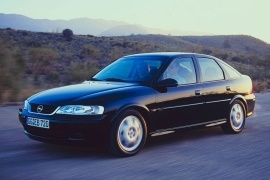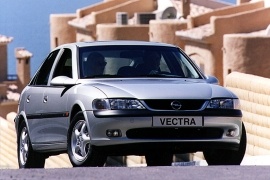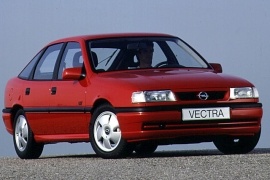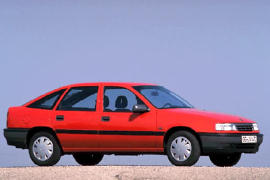OPEL Vectra Hatchback Models/Series Timeline, Specifications & Photos
First production year: 1988
Engines: Gasoline, Diesel
Body style: Hatchback
Opel prepared itself for the Euro 4 Emission standards and introduced a facelift for Vectra's second generation in 2005 for the entire range.
The German carmaker stayed true to its values and offered the Vectra a choice of three bodies: a sedan, a liftback (named GTS), and a station wagon. As usual, the hatchback, or liftback, was the middle road between the other two bodyworks, offering a bigger trunk than the sedan and a sportier look than the wagon.
Opel redesigned the entire front fascia. It didn't make just some small changes. There was a new pair of headlights swept-back over the hood and front fenders and a new grille. Its bumper sported new side scoops and raised outer sides. But the changes stopped there. The long greenhouse with a sloped tailgate remained the same, having the standard rear window wiper. The only difference was that the wiper was blade-style, not with the old system with brackets. Opel didn't change the taillights nor the chromed trim from the trunk.
Inside, the carmaker introduced a new infotainment unit with different buttons. Also, the instrument panel featured encircled dials and gauges. Another improvement was for the steering wheels, which received a new, three-spoke design and re-arranged buttons.
Under the hood, the GM installed a few new engines. Part of them, such as the 1.8-liter, was already Euro 4 compliant, but others were not. The most significant change was the introduction of the 2.8-liter turbocharged V-6, which replaced the older 3.2-liter unit built by Holden in Australia.
Like on its previous two generations, the Vectra saga's third and last sequel was available in three body shapes, with the GTS version as the sportiest-shaped one.
Opel was highly appreciated on the European market, and the Vectra was one of its best-selling products. It was available in three body shapes on its previous two generations: a sedan, a station wagon, and a hatchback (more of a fastback). The new platform provided more comfort thanks to its new independent rear suspension.
The exterior featured a new design trend for its headlights, with a rectangular, swept-back look and a pair of headlamps inside. Its grille sported a horizontal slat and the round badge on it. In the liftback version, the Vectra featured a longer rear window and, as you guessed, a liftgate. The GTS shape was the most aerodynamic among its siblings.
Inside, the cabin featured front bolstered seats, made for the European wingding roads, and soft enough for long travels. In the back, the manufacturer installed a bench with a 60/40 split-folding system, which could expand the trunk from 500 liters (17.6 cu-ft) to 1360 liters (48 cu-ft).
Opel offered a wide choice of engines under the hood ranged from four-mill 1.8-liter gasoline to a 3.2-liter V-6. Since turbo-diesel engines attracted European customers, the carmaker installed four oil burners, ranging between 120 hp and 177 hp.
Opel introduced the hatchback version for the Vectra's second generation in 1996 and facelifted it in 1999 when it added minor changes to the bodywork.
The Vectra nameplate was used in all the markets and all body shapes. It was available as a sedan, hatchback (liftback), and a station-wagon. Opel built the Vectra for all the markets, but it felt like home only on the European and British roads, where its agile chassis and fuel-efficient small-displacement engines fitted better than on long journeys at highway speeds.
The 1999 Vectra received a new bumper design and a chromed rim around the grille. It wasn't very clear if GM liked, or didn't, the bio-design trend, but it didn't want to ditch it completely. A particular shape was for the door-mirrors connected to the bodywork via an aerodynamic pillar that followed the hood's V-shaped line. Up to the B-pillar, it was the same vehicle as to the non-facelifted version. In the back, there was a new set of taillights.
Inside, the low-mounted bucket-seats at the front provided the impression of a sporty family sedan. The concept worked well for the front passengers but left little legroom for the rear ones. GM installed the same dashboard with curved lines, with a fluid line for the instrument cluster.
Opel offered the 1999 Vectra with a choice of six gasoline and three turbodiesel engines. The carmaker paired all of them to a five-speed manual gearbox. For selected versions, the Vectra was available with a four-speed automatic.
Opel launched the Vectra hatchback at the same time as its three-box sedan sibling at the 1995 Frankfurt Motorshow.
GM was not very satisfied with the sales results from the first Vectra generation. Despite being a modern vehicle, it couldn't convince too many customers to choose them instead of other cars, especially the Ford Mondeo. In comparison, the first generation of the Mondeo suffered from some design mishaps, but Opel nailed-it! With the hatchback version, the Vectra offered more room in the trunk and an appealing fastback look.
The 1995 Vectra was a significant improvement over its predecessor with more rounded areas and fluid shapes. A particular form was for the door-mirrors connected to the bodywork via an aerodynamic pillar that followed the hood's V-shaped lines. Up to the B-pillar, it was the same vehicle as to the sedan version, but after the C-pillar, it featured a sloped liftgate that offered a wide opening for the trunk.
Inside, the bucket-seats at the front were mounted low on the floor to create the impression of a sporty family sedan. The concept worked well for the front passengers but left little legroom for the rear ones. In the back, Opel installed a split-folding bench that expanded the trunk area. GM installed a refreshed dashboard with curved lines that looked appealing to its customers.
Opel offered the Vectra B with a choice of five gasoline and a turbodiesel engine under the hood. Later on, in 1997, it introduced a new generation of direct-injected diesel versions fitted with four valves per cylinder. The carmaker paired all of them to a five-speed manual gearbox. For selected versions, the Vectra was available with a four-speed automatic transmission.
Opel, the German branch of GM, facelifted the first generation of the Vectra in 1992, four years after the model's introduction on the European market.
The entire needed a refresh since the car-design trend had switched from the former wedged shapes to the new bio-design trend. Since the Vectra's lineup consisted of three versions: sedan, station wagon, and hatchback, the German automaker revised the entire range.
Opel was caught off-guard when it designed the Vectra and made it more like in the mid-80s style. Meanwhile, customers started to look more for rounded shapes, and the automaker promptly answered with the facelifted version. Thus, it shaved some edges here and there, made the headlights slightly smaller, and installed corner-mounted, clear-lenses blinkers at the front. In addition, the formerly used three-slat grille received a new, body-colored surrounding. Its new wrapped-around plastic bumper received an extension downwards, forming an apron and improving the car's aerodynamics. The hatchback looked even better thanks to its sloped rear tailgate, and it tried to mix a station wagon's advantages with the sedan's look.
Inside, Opel offered the Vectra with comprehensive trim options. From cloth upholstery to a leather-clad interior, cranked windows and a simple ventilation system to four power windows and mirrors, and automatic climate control. The front seats received new upholstery options, while the split-folding rear bench allowed customers to expand the trunk's space when needed.
Underneath the hood, the hatchback didn't get all the engines that were available for the sedan, such as the top-performer Cosworth powerplant. Yet, it still got the wide range of turbo-diesel units which were provided by Isuzu.
OPEL Vectra Hatchback 1.6i 5MT FWD (75 HP)
OPEL Vectra Hatchback 1.8i 4AT FWD (90 HP)
OPEL Vectra Hatchback 1.8i 5MT FWD (90 HP)
OPEL Vectra Hatchback 2.0i 16V 5MT AWD (204 HP)
OPEL Vectra Hatchback 2.0i 16V 5MT FWD (150 HP)
OPEL Vectra Hatchback 2.0i CAT 4AT FWD (115 HP)
OPEL Vectra Hatchback 2.0i CAT 5MT AWD (115 HP)
OPEL Vectra Hatchback 2.0i CAT 5MT FWD (115 HP)
Opel introduced the Vectra lineup in 1988 as a sedan and a station wagon, followed by the liftback version in the spring of 1989.
The times when Opel sold cars like hotcakes were gone, and the German automaker had to make a bold move to increase its market share. With funding from its owner, GM, the carmaker created a vehicle that was designed to be reliable, comfortable, and, most importantly, safe. That was the Vectra lineup. In addition, a sloped-down liftgate version not only that it followed in the footsteps of its predecessor, the Ascona, but also was the kind of vehicle that many Europeans wanted. A bodywork at the halfway between a sedan and a station wagon.
At the front, the Vectra featured a front fascia with rectangular headlights and corner-mounted turn signals. A three-slat plastic grille, black or body-colored depending on the trim level, filled the space above the wrapped-around plastic bumper. The car's greenhouse was longer than its sedan sibling, with a sloped-down tailgate. In addition, the automaker placed different side windows behind the rear doors to help the driver's visibility. Finally, at the back, the Vectra hatchback featured a rear fascia with corner-mounted taillights.
Inside, the base trim level featured cranked windows, manual adjustable mirrors, and a ventilation system. The full-spec version offered a leather-clad interior with power everything and a climate control system. Its front seats provided adequate room for average-sized occupants, while the rear split-folding bench was less comfortable due to limited legroom. But it was good enough for children and could also increase the trunk size.
Under the hood, Opel installed a 1.6-liter, single-point injection system that provided a mere 75 hp. The carmaker also offered two turbo-diesel versions with 1.7-liter displacement, Isuzu-sourced powerplants, which were highly fuel-efficient.
